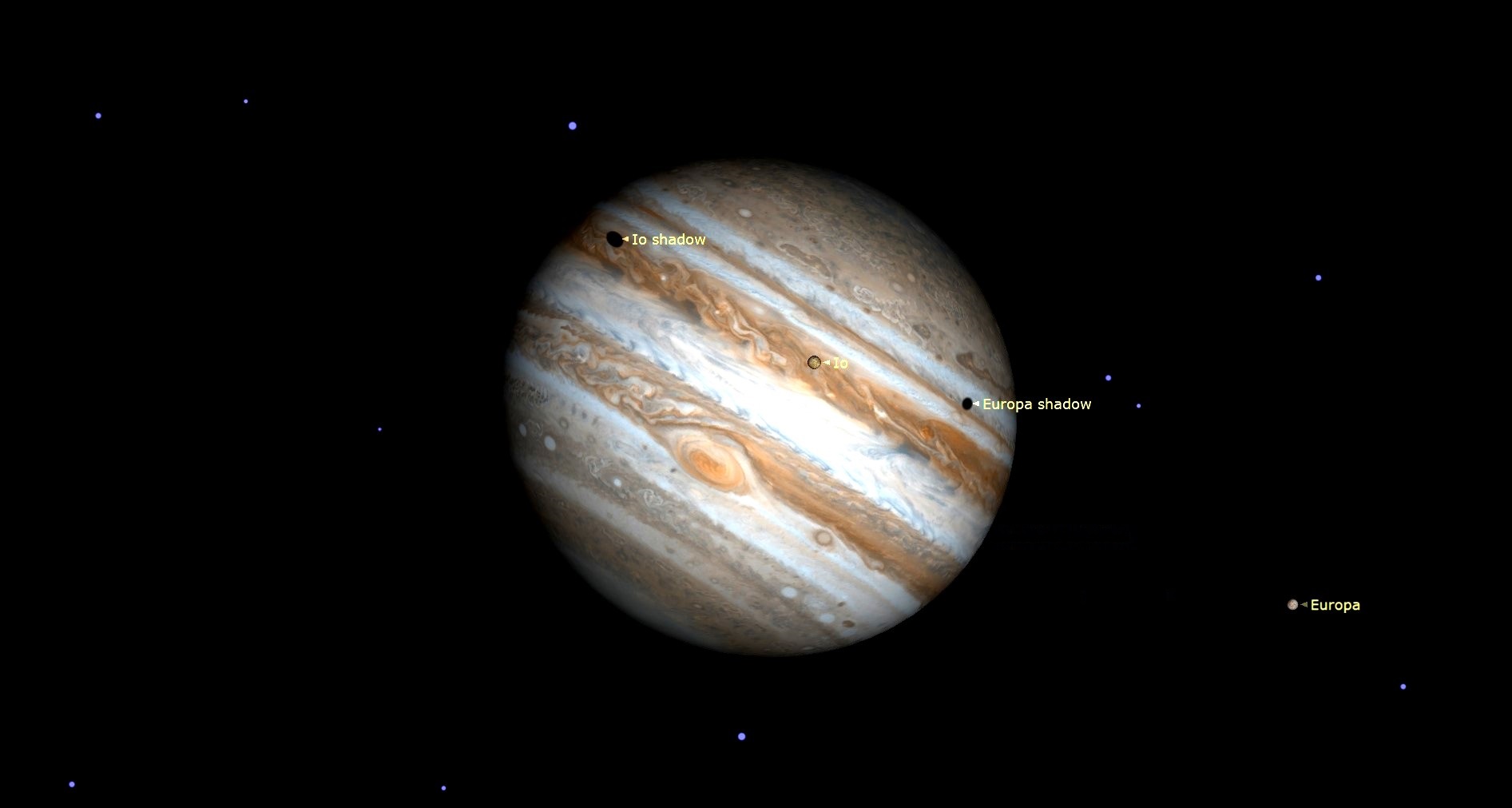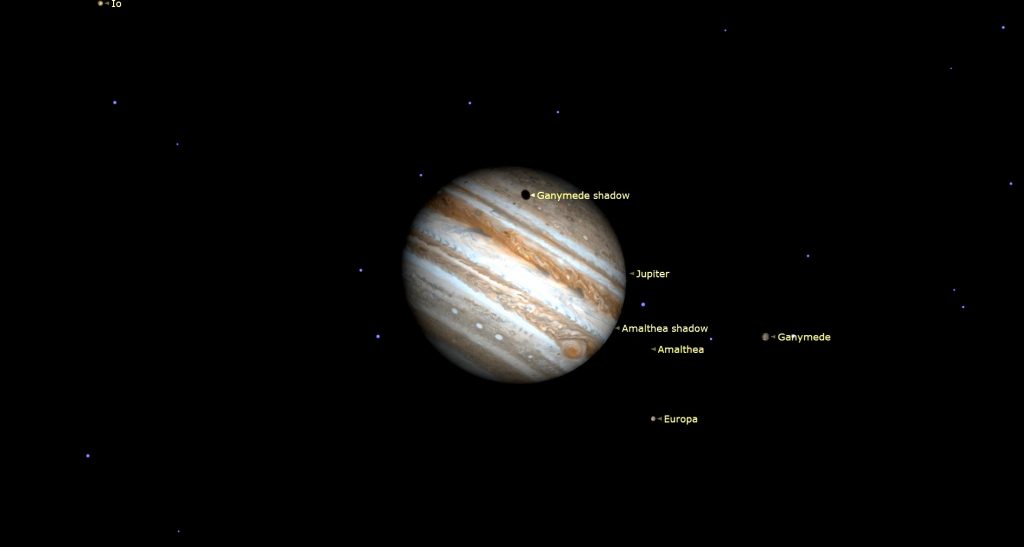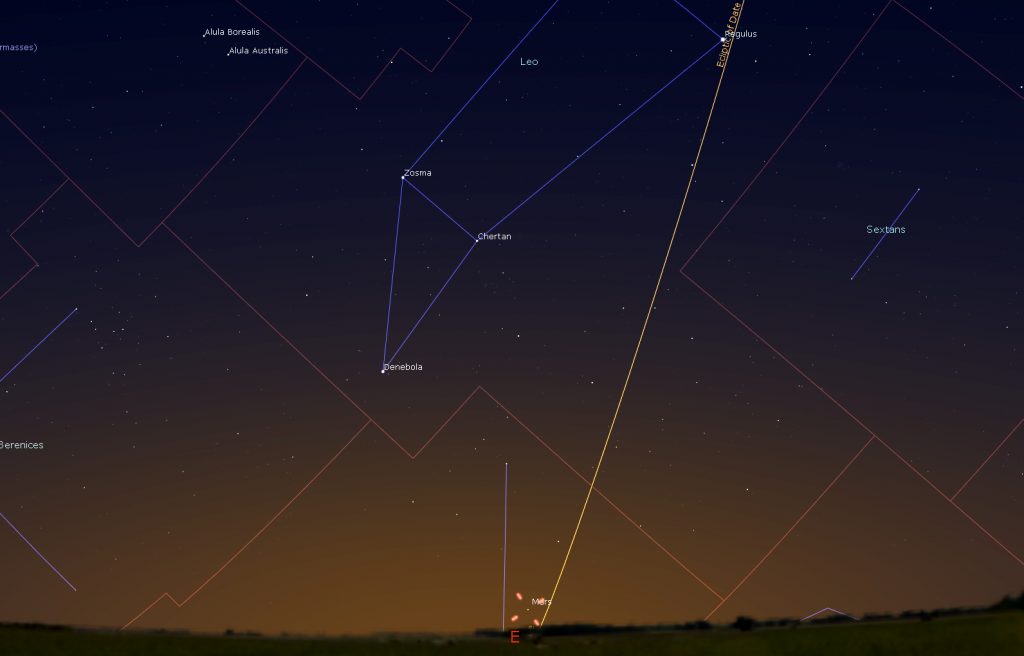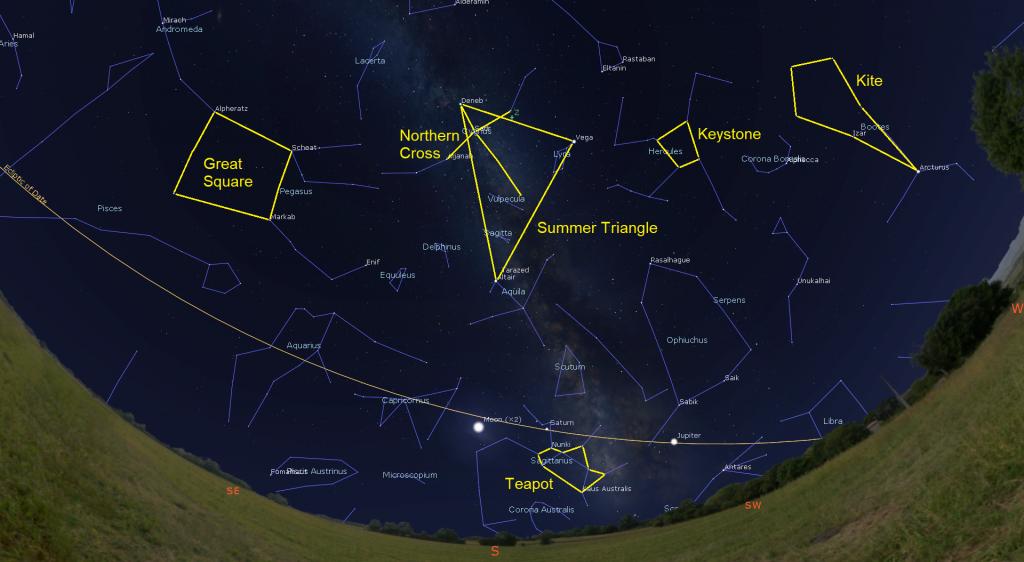The Dragon Spits Fire, the Full Moon is Puny, and Jupiter Sports Two Spots!

On Sunday evening, October 13, observers in the Americas can see a rare double-shadow transit on Jupiter. At dusk, Europa’s shadow will be midway across the northern hemisphere of the planet – accompanied by the Great Red Spot. Shortly before 8 pm EDT, Io’s shadow will join in the fun for approximately 35 minutes – until Europa’s shadow moves off the planet at about 8:28 pm EDT.
Hello, Early Autumn Stargazers!
Here are your Astronomy Skylights for the week of October 6th, 2019 by Chris Vaughan. Feel free to pass this along to your friends and send me your comments, questions, and suggested topics. You can also follow me on Twitter as @astrogeoguy! Unless otherwise noted, all times are Eastern Time. To subscribe to these emails please click this MailChimp link.
I can bring my Digital Starlab portable inflatable planetarium to your school or other daytime or evening event. Contact me through AstroGeo.ca, and we’ll tour the Universe together!
The Dragon Spits Fire
The annual Draconids meteor shower, which runs between October 6 and 10, will peak on the evening of Monday, October 8. At that time, the sky overhead will be plowing straight into the cloud of interplanetary debris that generates the shower. Normally, this is a modest shower – but it has been much more prolific some in years when the Earth encounters a denser patch of debris. Meteors are the streaks of light we see when tiny particles travelling at great speed ionize the atoms in our atmosphere. The material that produces the Draconids was deposited by repeated passages of periodic Comet 21P/Giacobini-Zinner. Unfortunately, the bright, waxing gibbous moon will wash out many of the fainter meteors.

To see more meteors, get away from light-polluted urban skies and find a dark site with plenty of open sky. Don’t bother with binoculars or a telescope – their fields of view are too narrow for meteors. You can start watching as soon as it is dark. True Draconids will appear to emanate from the sky near the stars that form the head of the constellation of Draco (the Dragon), and that gives this shower its name. But don’t watch the sky there – those meteors will be travelling towards you and will be very short. Just watch the sky overhead. Avoid bright white light from phones or tablets – it will spoil your eyes’ dark adaptation. We’ve now entered meteor season. A sequence of very good showers will occur over the next few months. Early risers might catch a few early Orionids this week.
The Moon and Planets
This is the second week of the moon’s monthly cycle. From tonight until next Sunday, the moon will wax in phase from first quarter to a puny full moon. It will also remain nicely placed for evening observing worldwide. Unfortunately, the bright moonlight will overwhelm the dimmer, more exotic targets in the night sky. But it will be a great week for seeing the brighter constellations and asterisms and for observing the moon and all the major planets – especially Jupiter, which will give us a rare double shadow transit next Sunday night. Here are the Skylights!
Tonight (Sunday) the moon will take up a position 1.4 fist diameters to the left (or celestial east) of Saturn. On evenings during this entire week, the moon will be nice and high in a dark sky – perfect for viewing in a backyard telescope. Take some time to look along the terminator, which is the pole-to-pole line that separates the lit and dark hemispheres. Near-horizontal sunlight arriving there casts long black shadows to the west and illuminates every elevated mountain, crater, ridge, or bump. Every night, the terminator shifts west, casting new parts of the moon into breathtaking relief – so there’s something new to see every night.
The moon will wax fuller until next Sunday, while it traverses the modest water constellations of Capricornus (the Sea-Goat), Aquarius (the Water-Bearer), and Pisces (the Fishes). On Sunday at 5:09 pm EDT, the full moon of October, traditionally called the Hunter’s Moon, Blood Moon, or Sanguine Moon, will occur. Indigenous groups have their own names for the full moons, which lit the way of the hunter or traveler at night before modern conveniences like flashlights. The Ojibwe people of the Great Lakes region call this one Mshkawji Giizia, the “Freezing Moon”. The Cree people of North America call it Pimahamowipisim, the “Migrating Moon”, when the birds fly south.

The October moon always shines in or near the stars of Cetus and Pisces. Since it’s opposite the sun on this day of the lunar month, the full moon rises at sunset and sets at sunrise. This full moon will occur a few days after reaching its greatest distance from Earth, or apogee – producing the smallest full moon of 2019. The opposite of a Supermoon – perhaps this one should be called a Punymoon!
Looking at the planets this week, Mercury and Venus are both in the western post-sunset sky. They are currently shifting farther from the sun, but the shallow evening ecliptic will prevent them from climbing above the glare of sunset for a while longer. If you can find a site with a low and open western horizon, you might be able to see Mercury and Venus sitting very low in the west for about half an hour after the sun disappears. Tonight (Sunday), Mercury will be positioned a generous palm’s width to the left (celestial southeast) of Venus. That separation will increase a little by next weekend. Observers near the equator and in the Southern Hemisphere will see those two inner planets very easily during the next couple of weeks.

The earlier-arriving sunsets of October are still giving us good views of spectacularly bright Jupiter, even though the planet is sliding west towards the sun every night. As the sky begins to darken this week, look for the giant planet sitting less than two fist diameters above the southwestern horizon. Hour by hour, Jupiter will sink lower – and then set in the west before 10 pm local time. Jupiter has spent this entire year below the stars of Ophiuchus (the Serpent-Bearer) and above Scorpius (the Scorpion). It will spend next year sitting quite close to Saturn!

On a typical night, even a backyard telescope will show you Jupiter’s two main equatorial stripes and its four Galilean moons – Io, Europa, Callisto, and Ganymede looking like small white dots arranged in a rough line flanking the planet. Good binoculars will show the moons, too! If you see fewer than four dots, then the missing ones are in front of Jupiter, or hidden behind it. Or, it might be that some moons are not being illuminated by sunlight because they are in eclipse!
From time to time, the small, round, black shadows cast onto Jupiter’s surface by those four Galilean moons become visible in amateur telescopes as they cross (or transit) Jupiter’s disk. Tonight, the shadow of Io will complete a passage at 8 pm EDT, accompanied by the Great Red Spot! On Friday evening, October 11, between 7:15 and 9:45 pm EDT observers in the Americas can see Ganymede’s shadow cross Jupiter’s disk – but only observers located west of the Great Lakes will see the entire transit.
Next Sunday evening, October 13, observers in the Americas can see a rare double-shadow transit on Jupiter. At dusk, Europa’s shadow will be midway across the northern hemisphere of the planet – accompanied by the Great Red Spot. Shortly before 8 pm EDT, Io’s shadow will join in the fun. Two shadows will both be visible for approximately 35 minutes – until Europa’s shadow moves off the planet at about 8:28 pm EDT. Io’s shadow transit will end at 10 pm EDT – after the planet has set for more easterly observers.

Due to Jupiter’s rapid 10-hour rotation period, the Great Red Spot (or GRS) is only observable from Earth every 2nd or 3rd night, and only during a predictable three-hour window. The GRS will be easiest to see using a medium-sized, or larger, aperture telescope on an evening of good seeing (steady air). If you’d like to see the Great Red Spot in your telescope, it will be crossing the planet tonight (Sunday evening) until 9 pm EDT, on Tuesday from 8 to 11 pm EDT, and on Friday, October 11 from dusk to 8:30 pm EDT – with the black shadow of Ganymede.
Yellow-tinted Saturn is prominent in the southern evening sky, too – but it is rather less bright than Jupiter. The ringed planet will be visible from dusk, when it will be about 2.5 fist diameters above the southern horizon, until almost 11 pm local time. Saturn’s position is just to the upper left (or celestial east) of the stars that form the teapot-shaped constellation of Sagittarius (the Archer).
A look at Saturn is well worth dusting off your old telescope! Once the sky is dark, even a small telescope will show Saturn’s rings and several of its brighter moons, especially Titan! Because Saturn’s axis of rotation is tipped about 27° from vertical (a bit more than Earth’s axis), we can see the top surface of its rings, and its moons can arrange themselves above, below, or to either side of the planet. During this week, Titan will migrate counter-clockwise around Saturn, moving from the left of Saturn tonight (Sunday) to the right of the planet next Sunday. (Remember that your telescope will flip the view around.)
Blue-green Uranus will be rising in the east at 7:30 pm local time this week; and it will remain visible all night long. The planet is sitting below (or to the celestial south of) the stars of Aries (the Ram) and is just a palm’s width above the circlet of stars that form the head of Cetus (the Whale). At magnitude 5.7, Uranus is actually bright enough to see in binoculars and small telescopes, under dark skies. You can use the three modest stars that form the top of the head of the whale (or sea-monster in some tales) to locate Uranus for the next several months – because the distant planet moves so slowly in its orbit. To help you find it, I posted a detailed star chart here.
Distant, blue Neptune is visible all night long among the stars of eastern Aquarius, less than a finger’s width to the right (or celestial west) of a medium-bright star named Phi (φ) Aquarii. Both blue Neptune and that golden-coloured star will appear together in the field of view of a backyard telescope at medium power. The distance between the star and the planet is steadily increasing due to Neptune’s westward retrograde orbital motion. I posted a diagram of Neptune’s position compared to that star here.

Mars is now pulling away from the sun’s glare in the eastern pre-dawn sky. It rises at about 6:20 am local time and will become more easily visible later this month. Unfortunately, the red planet is on the far side of the sun from us – so it will remain rather small and faint until early next year.
Constellations and Asterisms
This week’s full moon, and the mild temperatures of early autumn, are fine for viewing the patterns formed by the brightest stars in the night sky.
You are no doubt familiar with the notion of constellations – groups of stars that have been connected into obvious, or whimsical, groupings to represent pictures in the heavens. Those shapes are often used to illustrate a story or legend. In western astronomy (widely adopted by modern professional astronomers), precisely 88 constellations cover the entire celestial sphere, each one covering a specific area of the sky. A moving object, such as a planet, comet, or asteroid is considered to be in a particular constellation when it’s inside that constellation’s boundary. Many world cultures saw their own patterns in the stars in the parts of the sky that could be seen from those places (Inuit, Polynesians, etc.). For example, the curling hook of Scorpion’s stinger is Maui’s Fish Hook in New Zealand’s Maori culture!
An asterism is a set of (usually) prominent stars that form an obvious simple shape in the sky. In many instances the asterism borrows stars from adjacent constellations, or consists of the major parts of a larger constellation. The most famous of these is The Big Dipper, which consists of seven bright stars inside the larger constellation of Ursa Major (the Big Bear). The Big Dipper can be found low over the northern horizon in October.
Other asterisms include the Summer Triangle, composed of the bright stars Vega, Deneb, and Altair, and the Northern Cross, which is essentially the entire constellation of Cygnus (the Swan). For the past few months we’ve enjoyed The Teapot – part of Sagittarius (the Archer) and positioned low in the southern sky – and The Keystone, the core of Hercules. A number of astronomy apps allow you to replace the constellation lines with the major asterisms, or display both sets of lines.

The Teapot and the Summer Triangle are still visible now, but are beginning to leave the stage. A conveniently placed new autumn asterism is in Pegasus (the Flying Horse). Face east after dark and look for a gigantic square of modest stars tilted with one corner pointing down. All four stars are roughly the same brightness, about magnitude 2.5. At 8 pm local time, it is sitting about one-third of the way up the eastern sky, and the square measures two fist widths corner to corner. This asterism is known as the Great Square of Pegasus.
Clockwise from the top, the four corners of the great square are the stars Scheat, Markab, Algenib, and Alpheratz. Scheat is a cool red giant star about 200 light years distant, and is about one hundred times the diameter of our Sun. Visually, its red colour is readily detectable. Markab is a hot, blue-white star 140 light-years away that emits intense ultraviolet radiation. This rapidly spinning star is nearing the end of its time as a blue star and will soon evolve into an orange giant. Algenib is an extremely hot blue star with a luminosity of about 4,000 times that of our Sun! At 335 light years distant, it is the farthest of the four. Finally, Alpheratz, which is actually part of neighbouring Andromeda, is a hot blue sub-giant star located at a distance of only 97 light-years.
If you look closely at a spot midway between Scheat and Markab, and slightly outside of the square, you’ll find a dim star designated 51 Peg. This star’s claim to fame is that it hosts the first exo-planet discovered to be orbiting a sunlike star. It was discovered in 1995 using the radial velocity technique, in which the planet’s gravity tugs the star towards and away from our line of sight, altering its spectrum. The planet, named Bellerophon, is a Jupiter-sized object that orbits the star every 4.23 days (i.e., its year) at a distance of only 0.05 AU or 7.47 million km. That’s seven times closer to the star than Mercury is to our Sun! Bellerophon is obviously too hot for life, but 51 Peg has nevertheless been a target for SETI’s searches for extraterrestrial signals, because the star may host other more hospitable planets not yet detected.
Public Astro-Themed Events
Every Monday evening, York University’s Allan I. Carswell Observatory runs an online star party – broadcasting views from four telescopes/cameras, answering viewer questions, and taking requests! Details are here. On Wednesday nights they offer free public viewing through their rooftop telescopes, including their brand new 1-metre telescope. If it’s cloudy, the astronomers give tours and presentations. Registration and details are here.
At 7:30 pm on Wednesday, September 11, the RASC Toronto Centre will hold their free monthly Recreational Astronomy Night Meeting at the Ontario Science Centre, and the public are welcome. Talks include The Sky This Month, and two more about astrophotography. These meetings are also streamed live on RASC-TC’s YouTube channel. Check here for details. Parking is free.
On Thursday, October 10 from 4:30 to 7 pm, at York University’s New/Second Student Centre, 15 Library Lane, Toronto, The Universe Discovery Project in partnership with The Royal Canadian Institute for Science, will present a free interactive panel discussion entitled How Did We Get Here? The Cosmos, Humanity and the Unknown. Registration and details are here.
The next RASC-hosted Night at the David Dunlap Observatory will be on Saturday, October 19. There will be sky tours in the Skylab planetarium room, space crafts, a tour of the giant 74” telescope, and viewing through the 74” and lawn telescopes (weather permitting). The doors will open at 8:30 pm for a 9 pm start. Attendance is by tickets only, available here. If you are a RASC Toronto Centre member and wish to help us at DDO in the future, please fill out the volunteer form here. And to join RASC Toronto Centre, visit this page.
This Fall and Winter, spend a Sunday afternoon in the other dome at the David Dunlap Observatory! On Sunday afternoon, October 20, from noon to 4 pm, join me in my Starlab Digital Planetarium for an interactive journey through the Universe at DDO. We’ll tour the night sky and see close-up views of galaxies, nebulas, and star clusters, view our Solar System’s planets and alien exo-planets, land on the moon, Mars – and the Sun, travel home to Earth from the edge of the Universe, hear indigenous starlore, and watch immersive fulldome movies! Ask me your burning questions, and see the answers in a planetarium setting – or sit back and soak it all in. Sessions run continuously between noon and 4 pm. Ticket-holders may arrive any time during the program. The program is suitable for ages 3 and older, and the Starlab planetarium is wheelchair accessible. For tickets, please use this link.
Keep looking up, and enjoy the sky when you do. I love questions and requests – so, send me some!